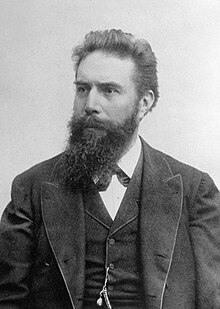Wilhelm Röntgen
| Wilhelm Röntgen | |
|---|---|
 |
|
| Born | Wilhelm Conrad Röntgen 27 March 1845 Lennep, Rhine Province, German Confederation |
| Died | 10 February 1923 (aged 77) Munich, Bavaria, Germany |
| Nationality | German/Dutch |
| Fields | |
| Doctoral advisor | August Kundt |
| Doctoral students | |
| Other notable students | Franz S. Exner |
| Known for | X-rays |
| Notable awards | Matteucci Medal (1896) Rumford Medal (1896) Elliott Cresson Medal (1897) Barnard Medal (1900) Nobel Prize in Physics (1901) |
| Signature | |
Wilhelm Conrad Röntgen (/ˈrɛntɡən, -dʒən, ˈrʌnt-/;German: [ˈvɪlhɛlm ˈʁœntɡən]; 27 March 1845 – 10 February 1923) was a German/Dutch mechanical engineer and physicist, who, on 8 November 1895, produced and detected electromagnetic radiation in a wavelength range known as X-rays or Röntgen rays, an achievement that earned him the first Nobel Prize in Physics in 1901. In honour of his accomplishments, in 2004 the International Union of Pure and Applied Chemistry (IUPAC) named element 111, roentgenium, a radioactive element with multiple unstable isotopes, after him.
Born to a German father and a Dutch mother, he attended high school in Utrecht, Netherlands. In 1865 he was expelled from high school when one of his teachers intercepted a caricature. Without a high school diploma, Röntgen could attend university in the Netherlands, but only as a visitor. In 1865, he tried to attend Utrecht University without having the necessary credentials required for a regular student. Upon hearing that he could enter the Federal Polytechnic Institute in Zurich (today known as the ETH Zurich), he passed its examinations, and began studies there as a student of mechanical engineering. In 1869, he graduated with a Ph.D. from the University of Zurich; once there, he became a favorite student of Professor August Kundt, whom he followed to the University of Strassburg (then recently annexed by Germany) in 1873.
...
Wikipedia
